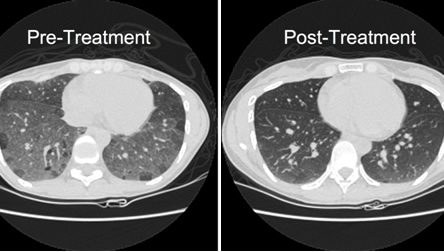
Pulmonary Function Testing
Case 6 Answer
A 30 year-old woman presents for evaluation of dyspnea on exertion which has been present for 2 months. She is a life-long non-smoker with no prior history of asthma or other pulmonary problems. She works as a receptionist at a publishing company. She has two cats and several parakeets at home.
Her pulmonary function testing is as follows:
| Pre-Bronchodilator (BD) | Post- BD | ||||
|---|---|---|---|---|---|
| Test | Actual | Predicted | % Predicted | Actual | % Change |
| FVC (L) | 1.73 | 4.37 | 40 | 1.79 | 4 |
| FEV1 (L) | 1.57 | 3.65 | 43 | 1.58 | 0 |
| FEV1/FVC (%) | 91 | 84 | 88 | - 3 | |
| RV (L) | 1.01 | 1.98 | 51 | ||
| TLC (L) | 2.68 | 6.12 | 44 | ||
| RV/TLC (%) | 38 | 30 | |||
| DLCO* corr | 5.13 | 32.19 | 16 | ||
| *DLCO is measured in ml/min/mmHg | |||||
Her flow volume loops is as follows:

Case 6 Interpretation
This patient has a markedly reduced FEV1 and FVC. However, the FEV1/FVC ratio is normal (91%) and, therefore, she cannot be classified as having obstructive lung disease. The pattern of reduced FEV1 and FVC with preserved FEV1/FVC ratio is often seen in restrictive processes but in order to confirm the diagnosis of restriction, you must examine the total lung capacity. For this patient, the TLC is markedly reduced at 41% of predicted and confirms that she has a restrictive process. Based on her TLC of < 50% predicted, she would be classified as having a “severe” restrictive defect. Her DLCO is also reduced suggesting she has a loss of alveolar-capillary surface area for gas exchange and also suggesting that the cause of her restriction is intrinsic to the lungs (i.e. due to a problem in the pulmonary parenchyma).
Further evaluation revealed that this patient had hypersensitivity pneumonitis, likely secondary to her exposure to parakeets. The parakeets were removed from her home and she was given a course of oral corticosteroids.
Following treatment, her repeat pulmonary function tests were improved, as was the CT scan of her chest:
| Pre-Treatment | Post- Treatment | |||||
|---|---|---|---|---|---|---|
| Test | Actual | Predicted | % Pred | Actual | Predicted | % Pred |
| FVC (L) | 1.73 | 4.37 | 40 | 3.00 | 4.35 | 69 |
| FEV1 (L) | 1.57 | 3.65 | 43 | 2.40 | 3.63 | 66 |
| FEV1/FVC (%) | 91 | 84 | 80 | 83 | ||
| RV (L) | 1.01 | 1.98 | 51 | 0.70 | 1.99 | 35 |
| TLC (L) | 2.68 | 6.12 | 44 | 3.70 | 6.11 | 61 |
| RV/TLC (%) | 38 | 30 | 19 | 30 | ||
| DLCO* corr | 5.13 | 32.19 | 16 | 13.61 | 32.04 | 32.04 42 |
CT Scan Images

UW School of Medicine : School of Medicine Mission
Copyright and Disclaimer : Credits and Acknowledgements